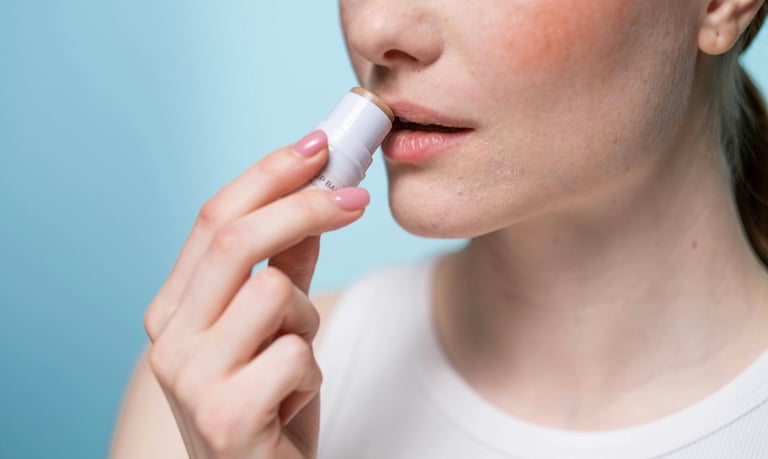Lip Care Is Having a Moment: The Simple 3-Step Routine That Actually Works
BEAUTYSKINCAREFEATURED
Essence & Style Team
11/7/20254 min read


Soft, smooth lips aren’t about scrubbing harder. They’re about sealing moisture in with intention.
Your lips deserve better than a quick swipe of gloss. When lips feel dry, tight, or rough, it is often a sign that the skin’s natural barrier is struggling. Because the skin on your lips is thinner and has fewer oil glands than the rest of your face, it loses moisture faster and shows stress sooner. A little bit of care goes a long way, and the modern lip routine focuses on comfort, smoothness, and lasting hydration rather than temporary shine.
Why Lips Dry Out So Easily
Lips are naturally more vulnerable to the environment. The outer layer of lip skin, called the stratum corneum, is thinner and holds less moisture, which makes lips more prone to water loss. A review published in the International Journal of Research Publication and Reviews notes that lip tissue has less natural oil protection compared to facial skin, which makes it sensitive to wind, cold air, and indoor heating.
This is why simple habits like licking your lips or relying on matte lipstick all day can contribute to dryness. The skin becomes rough, tight, or even cracked.
Fortunately, research also shows what helps. A clinical study published in the International Journal of Cosmetic Science found that highly occlusive formulations (Think of it as a little seal that keeps all that hydration from slipping away) improved lip roughness and restored moisture balance in as little as two to four weeks. The improvement came not from a trendy active ingredient but from preventing moisture from escaping in the first place.
Another study, published in Pharmacognosy Research, highlighted the effectiveness of balms made with natural emollients like shea butter, cocoa butter, and beeswax. These ingredients soften and smooth the lip surface while also providing a gentle protective barrier.
In other words, lips respond best to three things: draw moisture in, soften the surface, and then seal it all in place.
The Modern Lip Care Routine
This routine is intentionally simple. You can start today.
Step 1: Gentle Exfoliation (Once or Twice a Week)
Exfoliation helps lift away dry, flaky skin, so treatments absorb better. Choose a soft lip scrub or use a warm, damp cloth to wipe over lips after a shower. Avoid rough or daily scrubbing, which can make lips more fragile.
Step 2: Hydrate and Replenish Daily
During the day, choose a balm that includes humectants (like glycerin or hyaluronic acid) to draw moisture into the lips, and emollients (like shea butter or plant oils) to smooth texture. Apply after washing your face and reapply as needed, especially in air-conditioned or windy conditions.
Step 3: Seal in Moisture at Night
This is where the transformation happens. A richer balm or lip mask with occlusive ingredients such as beeswax, lanolin, or petrolatum alternatives prevents moisture loss while you sleep. Research shows that sealing moisture in overnight is what creates a visibly smoother lip surface over time.
Smart Lifestyle Shifts That Support Lip Health
Small habits make a noticeable difference.
• Use a humidifier if you sleep in air conditioning
• Wear lip SPF outdoors
• Avoid lip licking, which speeds up moisture loss
• Choose satin or balm textures when lips feel irritated
• Hydrate throughout the day to support natural moisture balance
Top Lip Care Product Picks to Support This Routine
These formulas follow the same simple rhythm your lips respond to best: hydrate first, then seal it all in. The research supports it, but you can feel it too. When lips get the water they need and then stay protected from the elements, they stay soft, smooth, and quietly luminous. It is less about treating dryness as a problem, more about giving your lips a little daily care so they look naturally well-tended.
Daily Nourishing Balms
Laneige Lip Glowy Balm
Lightweight shine with a hydrating finish. Layers well under lipstick.
Shop on Amazon
Summer Fridays Tinted Lip Butter Balm
Plush, cushiony texture that leaves lips soft and glossy.
Shop on Amazon
La Roche-Posay Cicaplast Lip Balm
A soothing balm with glycerin and panthenol that calms irritation and dryness.
Shop on Amazon
Overnight Repair Balms
Vaseline Lip Therapy Advanced Healing (White)
Locks in moisture and pairs well over a hydrating balm layer.
Shop on Amazon
Lansinoh Lanolin Lip Balm
Deeply occlusive and especially helpful for cracked or peeling lips.
Shop on Amazon
Tatcha Kissu Lip Mask
A silky treatment that restores softness with a smooth, slightly plumped finish.
Shop on Amazon
Gentle Exfoliators
Fresh Sugar Lip Polish
Soft sugar texture in a buttery base. Best once a week.
Shop on Amazon
e.l.f. Lip Exfoliator
Mess-free stick format that offers gentle, controlled exfoliation.
Shop on Amazon
When Lips Need Extra Repair
If your lips are already cracked, stinging, or peeling:
• Pause exfoliation for a few days
• Use a rich occlusive balm morning and night
• Avoid matte or long-wear lipsticks until lips recover
• Reduce spicy or citrus foods if they cause stinging
• Sleep with a heavier balm layer to support overnight repair
If cracks persist or become painful, a dermatologist can rule out irritation or infection.
Lip care works best as a small daily ritual rather than a quick fix. A little attention in the morning and a little at night slowly transforms the texture of your lips. Over time, lips look naturally plush and feel soft even without makeup. That soft glow looks effortless because it truly becomes effortless.
Disclosure: The advice and product recommendations in this article are for general guidance and inspiration. Since skincare is highly personal, results may vary depending on your individual skin type and concerns. Please remember to patch test new products before use to ensure compatibility with your skin. We also recommend consulting with a dermatologist or skincare expert before trying new products, especially if you have specific skin conditions. This article may also contain affiliate links, meaning we may earn a small commission if you make a purchase through them at no cost to you. We are also part of the Amazon Associates program.
